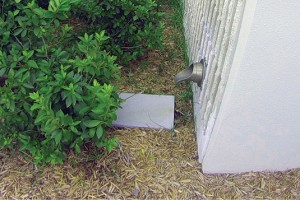
Plant growth eventually will conceal the perfect pest harborage developing against this building.
Photo: Jeff McGovern
From the street or sidewalk, this newly refurbished office building appears well landscaped and free of pest problems. However, as plant growth accelerates during warmer months, the problems just barely visible now will be concealing the perfect pest harborage developing against the building.
For example, the roof drain deflector is positioned just out of place. Water is draining under it and becoming trapped against the building, making it an ideal environment for grass and weeds.
The mulch has been laid right up to the foundation. This will evolve into more harborage and holds more moisture against the structure.
The bushes are allowed to encroach close to the structure. The combination of moisture, lack of airflow and harborage creates a jungle environment against the building, which is the ultimate living and breeding site for insects and rodents.
These conditions eventually will damage the exterior and will create breaches where pests can enter and forage. If this area is left unchecked, rodents will become comfortable and establish harborage. Proper assessments, evaluations and treatments will be difficult to provide because the problem areas will be masked by the growth, and become nearly impossible to reach without significant landscape changes and repairs.
The best time to address planted areas is during installation. A gravel bed, installed between the garden and the structure, creates an unfriendly and inhospitable zone for pests and plants. Eighteen to 24 in. of gravel, 8 to 10 in. deep, creates a clear zone open to regular assessment and pest management services.
You can reach Jeff and Kate McGovern at jeffreymcgovern@mindspring.com.
Leave A Comment